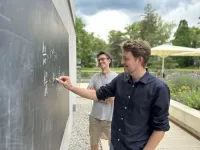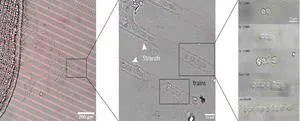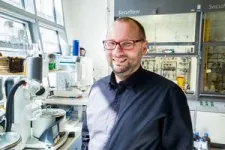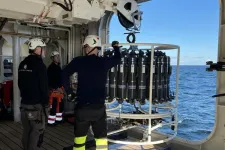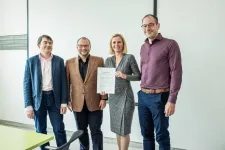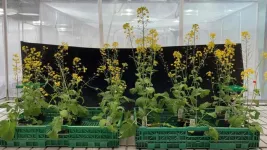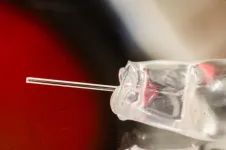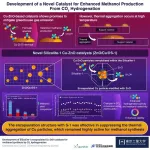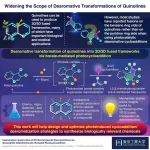(Press-News.org) Looking under the microscope, a group of cells slowly moves forward in a line, like a train on the tracks. The cells navigate through complex environments. A new approach by researchers involving the Institute of Science and Technology Austria (ISTA) now shows how they do this and how they interact with each other. The experimental observations and the following mathematical concept are published in Nature Physics.
The majority of the cells in the human body cannot move. Some specific ones, however, can go to different places. For example, in wound healing, cells move through the body to repair damaged tissue. They sometimes travel alone or in different group sizes. Although the process is increasingly understood, little is known about how cells interact while traveling and how they collectively navigate the complex environments found in the body. An interdisciplinary team of theoretical physicists at the Institute of Science and Technology Austria (ISTA) and experimentalists from the University of Mons in Belgium now has new insights.
Much like social dynamics experiments, where understanding the interactions of a small group of people is easier than analyzing an entire society, the scientists studied the traveling behavior of a small group of cells in well-defined in vitro surroundings, i.e. outside a living organism, in a Petri dish equipped with interior features. Based on their findings, they developed a framework of interaction rules, which is now published in Nature Physics.
Cells travel in trains
David Brückner rushes back to his office to grab his laptop. “I think it’s better to show some videos of our experiments,” he says excitedly and presses play.
The video shows a Petri dish. Microstripes—one-dimensional lanes guiding cell movement—are printed on the substrate beside a zebrafish scale made up of numerous cells. Special wound-healing cells, known as “keratocytes” start to stretch away from the scale, forming branches into the lanes. “At first, cells stick together through adhesive molecules on their surface—it’s like they’re holding hands,” explains Brückner. Suddenly, the bond breaks off, and the cells assemble into tiny groups, moving forward like trains along tracks. “The length of the train is always different. Sometimes it's two, sometimes it's ten. It depends on the initial conditions.”
Eléonore Vercurysse and Sylvain Gabriele from the University of Mons in Belgium observed this phenomenon while investigating keratocytes and their wound-healing features within different geometrical patterns. To help interpret these puzzling observations, they reached out to theoretical physicists David Brückner and Edouard Hannezo at ISTA.
Cells have a steering wheel
“There’s a gradient within each cell that determines where the cell is going. It’s called ‘polarity’ and it’s like the cell’s very own steering wheel,” says Brückner. “Cells communicate their polarity to neighboring cells, allowing them to move in concert.” But how they do so has remained a big puzzle in the field.
Brückner and Hannezo started brainstorming. The two scientists developed a mathematical model combining a cell’s polarity, their interactions, and the geometry of their surroundings. They then transferred the framework into computer simulations, which helped them visualize different scenarios.
The first thing the scientists in Austria looked at was the speed of the cell trains. The simulation revealed that the speed of the trains is independent of their length, whether they consist of two or ten cells. “Imagine if the first cell did all the work, dragging the others behind it; the overall performance would decrease,” says Hannezo. “But that’s not the case. Within the trains, all the cells are polarized in the same direction. They are aligned and in sync about their movement and smoothly move forward.” In other words, the trains operate like an all-wheel drive rather than just a front-wheel drive.
As a next step, the theoreticians examined the effects of increasing the width of the lanes and the cell clusters in their simulations. Compared to cells moving in a single file, clusters were much slower. The explanation is quite simple: the more cells are clustered together, the more they bump into each other. These collisions cause them to polarize away from each other and move in opposite directions. The cells are not aligned properly, which disrupts the flow of movement and drastically influences the overall speed. This phenomenon was also observed in the Belgian lab (in vitro experiments).
Dead end? No problem for cell clusters
From an efficiency standpoint, it sounds like moving in clusters is not ideal. However, the model predicted that it also had its benefits when cells navigate through complex terrain, as they do, for instance, in the human body. To test this, the scientists added a dead end, both in the experiments and in the simulations. “Trains of cells get to the dead end quickly, but struggle to change direction. Their polarization is well aligned, and it’s very hard for them to agree on switching around,” says Brückner. “Whereas in the cluster, quite a few cells are already polarized in the other direction, making the change of direction way easier.”
Trains or clusters?
Naturally, the question arises: when do cells move in clusters, and when do they move in trains? The answer is that both scenarios are observed in nature. For example, some developmental processes rely on clusters of cells moving from one side to the other, while others depend on small trains of cells moving independently. “Our model doesn’t only apply to a single process. Instead, it is a broadly applicable framework showing that placing cells in an environment with geometric constraints is highly instructive, as it challenges them and allows us to decipher their interactions with each other,” Hannezo adds.
A small train packed with information
Recent publications by the Hannezo group suggest that cell communication propagates in waves—an interplay between biochemical signals, physical behavior, and motion. The scientists’ new model now provides a physical foundation for these cell-to-cell interactions, possibly aiding in understanding the big picture. Based on this framework, the collaborators can delve deeper into the molecular players involved in this process. According to Brückner, the behaviors revealed by these small cell trains can help us understand large-scale movements, such as those seen in entire tissues.
-
Information on animal studies
In order to better understand fundamental processes, for example, in the fields of neuroscience, immunology, or genetics, the use of animals in research is indispensable. No other methods, such as in silico models, can serve as alternative. The animals are raised, kept, and treated according to the strict regulations of the respective countries, the research was conducted (Belgium).
END
A railroad of cells
Computer simulations explain cell movement
2024-06-19
ELSE PRESS RELEASES FROM THIS DATE:
Much of the Nord Stream gas remained in the sea
2024-06-19
Much of the methane released into the southern Baltic Sea from the Nord Stream gas pipeline has remained in the water. This is shown by measurements taken by researchers from the University of Gothenburg.
At the end of September 2022, the Nord Stream gas pipeline on the bottom of the Baltic Sea exploded east of Bornholm and one of the largest unnatural methane gas emissions ever was a fact. The methane gas from the pipeline created large bubbles at the water surface and measurements showed elevated levels of methane in the atmosphere.
Expedition ...
Dwindling arousal levels during brain scans have been distorting fMRI results, study shows
2024-06-19
In a new study, investigators from McLean Hospital (a member of Mass General Brigham), Harvard Medical School and the National Institute on Drug Abuse – Intramural Research Program (NIDA-IRP) discovered that the tendency of people’s arousal to wane over the course of brain scans has been distorting the brain connection maps produced by functional magnetic resonance imaging (fMRI). The team found that as people’s arousal levels dwindle during an fMRI, such as if they become more relaxed and sleepy, changes in breathing and heart rates alter blood oxygen levels in the ...
New Czech company linked to IOCB Prague to enter global gene therapy field
2024-06-19
Technology from the laboratories of IOCB Prague has been given an extraordinary opportunity to succeed in the rapidly developing segment of gene therapy. The results of successful research are set to be advanced by a newly established private company called Adalid Sciences, which is being supported with a major investment from BTL Group, a leading manufacturer of medical technologies.
The story begins with the discovery of new lipid nanoparticles with a comic book name coined by Dr. Petr Cígler and Dr. Klára Grantz Šašková of IOCB Prague. Acting as a sort of imaginary courier, their XMAN is capable of safely ...
New findings: East Palestine train derailment caused chemical pollution falling to the earth surface across the US and beyond
2024-06-19
A new study published in the academic journal Environmental Research Letters, reveals that the environmental impact of the February 3, 2023, Norfolk Southern train accident in East Palestine, Ohio covered a very large geographical area. Inorganic pollutants released due to the accident were found in wet weather downfall (wet deposition) from the Midwest through the Northeast reaching as far as southern Canada and North Carolina. The findings are significant as many inorganic pollutants in rain and snow have chemical effects on - aquatic flora and fauna. According to the paper, these pollutants spread over at least portions of 16 states and an area of 1.4 million ...
Interaction with insects accelerates plant evolution
2024-06-19
A team of researchers at the University of Zurich has discovered that plants benefit from a greater variety of interactions with pollinators and herbivores. Plants that are pollinated by insects and have to defend themselves against herbivores have evolved to be better adapted to different types of soil.
Plants obtain nutrients and water from the soil. Since different soil types differ in their chemical and physical composition, plants need to adapt their physiology to optimize this process on different soil types.
This evolutionary ...
More effective cancer treatment with iontronic pump
2024-06-19
When low doses of cancer drugs are administered continuously near malignant brain tumours using so-called iontronic technology, cancer cell growth drastically decreases. Researchers at Linköping University, Sweden, and the Medical University of Graz, Austria, demonstrated this in experiments with bird embryos. The results, published in the Journal of Controlled Release, is one step closer to new types of effective treatments for severe cancer forms.
Malignant brain tumours often recur despite surgery and post-treatment with chemotherapy and radiation. This is because cancer cells can “hide” deep within tissue and then regrow. ...
Ultrasound beam triggers ‘nanodroplets' to deliver drugs at exactly the right spot
2024-06-19
Conventional drug delivery is often like cracking a nut with a sledgehammer. Whether the drug is swallowed, injected, inhaled, or absorbed through the skin, it ultimately diffuses to most parts of the body, including those where it isn’t needed – or where it even might cause harm.
But what if the delivery could be targeted at exactly the right spot? This would allow the total dose to be dramatically lower, thus minimizing side-effects.
Now, scientists from the US have found a way to perfect a promising, ...
Blessing in disguise: Mycoviruses enhance fungicide effectiveness against plant pathogens
2024-06-19
Osaka, Japan — As detrimental as viruses may sound, they can be helping hands for farmers when it comes to dealing with plant pathogens.
Osaka Metropolitan University scientists have discovered that a mycovirus that infects plant pathogenic oomycete Globisporangium ultimum can increase the latter’s sensitivity to specific fungicides. Their findings could lead to innovative approaches for controlling plant diseases, reducing reliance on chemical treatments, and minimizing agricultural loss.
Their results were published in Microbiological Research ...
A novel signal-amplification system utilizing sumanene-based supramolecular polymers
2024-06-19
Chemical sensors whose signals can be amplified by various triggers hold huge potential in multidisciplinary sciences. However, developing such systems was considered a highly challenging task, until a team of researchers from Tokyo Tech recently came up with a novel signal-amplification system that can be flexibly manipulated by a dynamic allosteric effector or a trigger. This new chemosensor system exhibited exception signal amplification by altering the sumanene monomer concentrations.
Synthetic supramolecular hosts and artificial receptors have found an exciting application in the form of chemical sensors or chemosensors, ...
Transforming inexpensive quinolines into complex drug candidates
2024-06-19
An innovative synthesis strategy opened up the way to 2D/3D fused frameworks using inexpensive quinolines as feedstock, report scientists from Tokyo Tech. By leveraging a light-sensitive borate intermediate, the scientists could transform quinoline derivatives into a great variety of 2D/3D fused frameworks in a straightforward and cost-effective manner. Their findings are expected to enable the synthesis of highly customizable drug candidates.
Quinolines have garnered much attention from chemists wanting to synthesize compounds known as 2D/3D fused frameworks. These complex organic molecules have a lot of medical potential due to their highly ...
LAST 30 PRESS RELEASES:
Numbers in our sights affect how we perceive space
SIMJ announces global collaborative book project in commemoration of its 75th anniversary
Air pollution exposure and birth weight
Obstructive sleep apnea risk and mental health conditions among older adults
How talking slows eye movements behind the wheel
The Ceramic Society of Japan’s Oxoate Ceramics Research Association launches new international book project
Heart-brain connection: international study reveals the role of the vagus nerve in keeping the heart young
Researchers identify Rb1 as a predictive biomarker for a new therapeutic strategy in some breast cancers
Survey reveals ethical gaps slowing AI adoption in pediatric surgery
Stimulant ADHD medications work differently than thought
AI overestimates how smart people are, according to HSE economists
HSE researchers create genome-wide map of quadruplexes
Scientists boost cell "powerhouses" to burn more calories
Automatic label checking: The missing step in making reliable medical AI
Low daily alcohol intake linked to 50% heightened mouth cancer risk in India
American Meteorological Society announces Rick Spinrad as 2026 President-Elect
Biomass-based carbon capture spotlighted in newly released global climate webinar recording
Illuminating invisible nano pollutants: advanced bioimaging tracks the full journey of emerging nanoscale contaminants in living systems
How does age affect recovery from spinal cord injury?
Novel AI tool offers prognosis for patients with head and neck cancer
Fathers’ microplastic exposure tied to their children’s metabolic problems
Research validates laboratory model for studying high-grade serous ovarian cancer
SIR 2026 delivers transformative breakthroughs in minimally invasive medicine to improve patient care
Stem Cell Reports most downloaded papers of 2025 highlight the breadth and impact of stem cell research
Oxford-led study estimates NHS spends around 3% of its primary and secondary care budget on the health impacts of heat and cold in England
A researcher’s long quest leads to a smart composite breakthrough
Urban wild bees act as “microbial sensors” of city health.
New study finds where you live affects recovery after a hip fracture
Forecasting the impact of fully automated vehicle adoption on US road traffic injuries
Alcohol-related hospitalizations from 2016 to 2022
[Press-News.org] A railroad of cellsComputer simulations explain cell movement
